
These quilts were part of the Fabric of a New Nation, 1776-1840 exhibit at the Art Institute of Chicago.
As I said in my previous post, the quilts were really great.
I like the name of this quilt -Cockscomb, Rose Tree & Pineapple. The words evoke an English garden for me.
I think the quilt, in general, evokes a slightly wild garden. I have to say that I see the Pineapple as more implied than a true rendition of one. I won’t quibble too much, though.
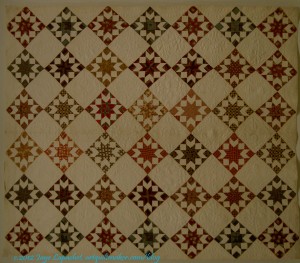
I am partial to 8 pointed stars, so this quilt really attracted my attention. This quilt is attributed to Margaret Blean, 1811-1887. The best design aspect of this quilt is the border around each of the blocks. That little border really makes the stars stand out. There could be too much with the border, but the plain blocks really give the blocks space to shine.
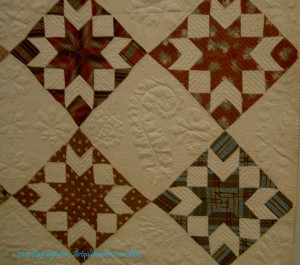
In looking closely at the blocks, I can see that the border adds a couple of extra diamonds to the block, which, I know, makes some quiltmakers sweat. As I said in the distant past sewing slowly and using the Jinny Beyer Perfect Piecer ruler to help with the inset seams really makes them doable. By the way, Jinny Beyer has a video and a guide to using the Perfect Piecer, which you can look at before you buy. I have been using the Perfect Piecer for awhile and learned a new trick watching the video.
Once you have done a few inset seams a few more make little to no difference. 😉
In the detail photo, the quilting is clearly visible, which looks looser than other quilting in the exhibit.
I would be doing the quilt a disservice, if I neglected to mention the fabric. There are a lot of nice plaids and I like the blue grey colors as well. The other thing I noticed was that the quilt is made from browns/earth tones/neutrals. Not always my favorites, but I like them in this quilt. Of course, I wonder how the quilt would look in brights with hot pink or lime green as a background.

I had whole cloth quilts on my mind after attending the July BAMQG meeting. Ruth spoke eloquently about the latest challenge – a whole cloth challenge. When I heard about it, I immediately said NO WAY, but I couldn’t get the idea out of my head. Visiting the Art Institute fed the inspiration fire. Don’t Ask.
This is a beautiful example of a whole cloth quilt by Ursula Whittlesey, 1796-1875. Think about Ursula for a moment. She was born just after the Revolutionary War, saw the War of 1812 and the Civil War as well as untold US expansion. And I was at a museum looking at her quilt. Just thinking about that makes my mouth drop open. I wish these women kept journals. If you don’t keep a journal, even just to chronicle your creativity, start. Start NOW.
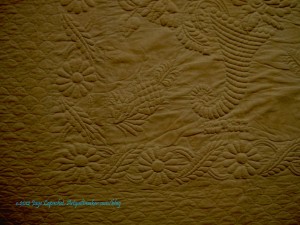
I thought the border of the whole cloth piece was nice. It is not an edge border, but a center border, like the mat of a framed picture. It is elaborate, but also simple with the repetition of the flowers and the wreath-like leaves. Of course, I had to take a photo of the corner. As I have mentioned, corners can be tricky, so I be sure and take note of them so I don’t have to make something crazy up myself. Looking at the corner detail made me notice the pineapple in the corner. I believe that pineapples symbolize hospitality. I carefully took photos and notes and did sketches, thinking that it might work as inspiration for a piece of my own sometime.
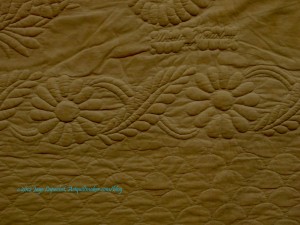
One thing I like about the frame is that the flowers are simple. Of course, If I tried to machine quilt them, they would be complicated enough, but they are not complicated flowers. They are simple daisies (I guess).
Also the wreath-like leaves are complicated in front and simple behind, which probably made the quilting easier, but also make the front leaf stand out. If you look at the design one might think that the simple background part of the leaf could be attached to the flower. Who knows? It is fun to look at it and speculate.
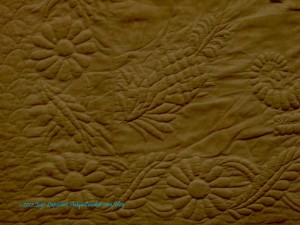
Finally, I have to go back to the pineapple. This is one of the best pineapple designs that I have seen. It is a bit stylized, but not a lot. A person can really tell what it is.
I also notice that it is its own design. The leaves are different from the wreath-like flower-leaf border, but it is connected to the cornucopia by the suggestion of abundance.
I guess the lesson is: go to a museum, get inspired there and pay homage to the woman who made these works and, probably, never thinking that their work would be in a museum.
Thank you for sharing part of the exhibit in your posts. The pictures and descriptions are wonderful!
I’ve been taking pictures of inspiring “things” for a long time, but only since reading your blog have I been capturing the corners in a deliberate way. Just yesterday I saw a metal grate and took pictures for quilting ideas…while hearing your voice telling me to get the corner. lol
k
Always glad to be of service!
Jaye, thanks for posting this. The quilts.are.amazing and I really appreciate your descriptions and observations, too. I would love to know more about the makers and the details of their lives. Thx for all the great posts.
Not sure how we can know more about the women. I think it is important, going forward, to chronicle our own lives so that people like us in the years to come will have journals and notes to which to refer.